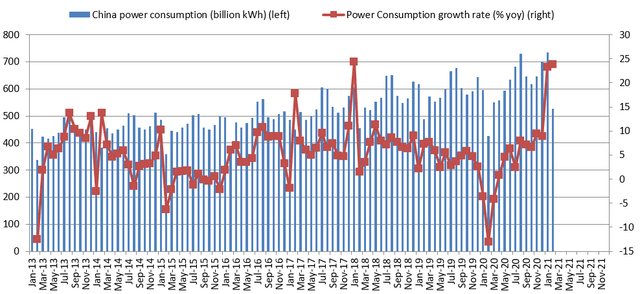While the rest of the world is in semi-lockdown and hoping the COVID vaccines will return the world to normalcy, China is growing its economy with skyrocketing electricity demand and massive production and exports. Unlike California, Texas, and Germany, China is not relying on wind and solar power to generate its electricity. Rather, it is building coal plants galore. In areas of China where coal plants dominate, electricity prices are low, allowing those areas to become meccas of manufacturing. And Mexico, our southern neighbor, is following somewhat in these footsteps, relying on its domestic-owned power first before using its solar and wind plants to generate power. But the Biden administration is ignoring these countries’ policies and plowing ahead with transitioning to a carbon-free generating sector by 2035, as the President promised during his campaign.
China’s Electricity Growth
China’s electricity consumption, a key barometer of economic activity, soared 22 percent in the first two months of this year as the country’s economy continued to restore growth. China added 38.4 gigawatts of new coal-fired power capacity in 2020—more than three times the amount built elsewhere around the world. Including decommissions, China’s coal-fired fleet capacity rose by a net 29.8 gigawatts in 2020, despite the rest of the world making cuts of 17.2 gigawatts. China approved the construction of another 36.9 gigawatts of coal-fired capacity last year, three times more than a year earlier, bringing the total under construction to 88.1 gigawatts. It now has 247 gigawatts of coal power under development, enough to supply all of Germany and more than the entire U.S. coal fleet of 218 gigawatts. China’s latest 5-year plan released earlier this month indicates a continuation of its coal investments in the power sector.

China has a massive trade surplus which will be used to increase construction, infrastructure and manufacturing. China is the largest consumer of commodities in the world and as the world’s electrification continues, it will need to import certain commodities such as copper, nickel, iron ore, and oil. Copper is an important commodity used in electric vehicles and renewable energy sources. Some forecasters believe that there will be a massive deficit in copper in 2021, increasing its already soaring price further. Nickel’s price has also surged to 7-year highs as automakers continue to ramp up electric vehicle production in response to government policies.
Mexico’s Reformed Electricity Law
Mexico’s Reformed Electricity Law (the Law) modifies the dispatch rules in Mexico’s National Electric System to favor power plants owned by the Federal Electricity Commission (CFE or Comisión Federal de Electricidad), which are not intermittent renewable plants. In Mexico, intermittent renewable plants (wind and solar) are privately owned and will no longer be dispatched first. Instead, the hydroelectric plants will be dispatched into the power grid first, then nuclear, geothermal, combined cycle and thermoelectric power plants owned by CFE. In third place, the solar and wind power stations owned by private entities will be dispatched and, lastly, the combined cycle power stations owned by private entities. By moving the dispatch order to include the intermittent technologies later, the system would be more robust and resilient.
When over 4.5 million homes and businesses in northern Mexico lost power last month after arctic weather froze cross-border pipelines and the governor of Texas issued an order to restrict natural gas exports, Mr. López Obrador, Mexico’s President, said it was a lesson in the need for energy independence. Natural gas-fired plants generate more than half of Mexico’s power; the vast majority of the natural gas is imported, with most of it coming from the United States.
When the cold spell hit Texas, much of the state’s wind power plants were down due to the freeze. Despite being also affected by the cold spell, the northern U.S. states were able to keep the lights on with coal generating 43 percent of electricity on February 15 in the 15-state power grid including much of Minnesota, and with natural gas contributing an additional 29 percent. In those northern areas, natural gas lines are buried deeper underground to prevent freezing and power plants are enclosed and insulated to guard against the cold. In New York, for example, some gas plants are equipped with oil backup in case pipelines freeze or heating demand surges. These states were able to supply power without needing intermittent renewable energy.
Conclusion
The Biden administration wants to make the U.S. electric system carbon free by 2035, thereby making it less resilient and less supply diverse, which could result in power outages as seen in Texas and California. The result of the transition to wind and solar power in these states is that homeowners not wanting to risk being without electricity are buying gasoline and diesel generators, thereby negating the carbon free aspects of the wind and solar power plants. Biden’s policies are not in line with China’s nor are they in line with our southern neighbor, Mexico. Both countries are giving priority to non-intermittent technologies.



